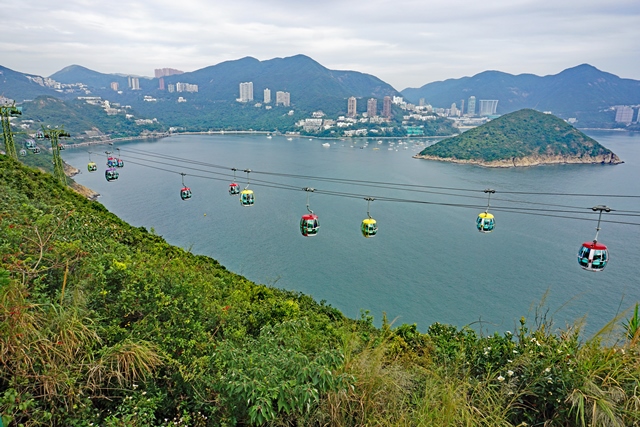Today, we were keen to see the revamped Ocean Park as we last visited it more than 10 years ago. Then, China had just liberalised visas for mainland tourists and the place was swamped by huge groups, every attraction demanded lengthy queues and the exit lines were...humongous. When you were visiting with a couple of teenagers in tow, it made for a l-o-n-g day.
Today, it was just the two of us and we were taking advantage of the new South Island Line of the MTR (Mass Transit Railway, Hong Kong's uber efficient underground railway) that opened yesterday; its four minute commute in air-conditioned comfort replaces the previous half-hour coach journey from Admiralty to Ocean Park.
The MTR decamped us at the entrance to Ocean Park. The picture below shows the bridge from the train station to the Park. The day was dull, overcast but dry and warm at about 17 Censius.
First stop was something billed as a half-hour 'Cyber-Illusion Spectacular.'
That involved loud music, flashing lights, robotic dancers - and some excellent magic and illusions, the best involving a couple who performed multiple costume changes in less than ten seconds with only a flimsy sheet as cover; indeed the girl once changed costume in the couple of seconds that it took for a falling stream of petals to obscure her. The applause at the end was well deserved.
Because we've visited the Ocean Park several times before, we planned to be selective in our visits, avoiding anything strenuous (so the adventure games were out) and focusing on old favourites and additions since our last visit.
The Old Hong Kong display of stalls, birdcages, a tram, phonebox, posters and so on is pure nostalgia. The prices charged by the stalls for 'old time' food treats will bring tears to your eyes and make your wallet much lighter.
We took the cable car from the lower Waterfront side of the Park to the Headland side where many of the rides and attractions are situated. Each car holds six passengers and there must be a couple of hundred of them in the air at any one time.
It's a spectacular ride, moving gently through the air with views out past the south coast to the expanse of the South China Sea. Today it was misty and visibility was restricted but several large cargo ships and fishing boats could be seen making their way into Aberdeen port.
Our first stop on the headland was the Rainforest Attraction that presents animals from the world's rain forests, particulary from South America. Apart from the snakes and tree frogs, one of my favourites was the alligator gar, a large, prehistoric-looking fish native to north and south America. They grow to ten feet long and their ancestors lived over 100 million years ago.
We looked in vain for the seals in the Polar Adventure Attraction but they dived out of sight when they saw us coming.
In fact, when we spotted the crowd rushing to one particular viewing window we thought they had a good sight of the seals ...but the object of their excitement was two-legged, a diver.
Mind you, the penguins made up for it. They were waddling around, chests out, arms outstretched, looking the audience up and down as if they were assessing us.
Back on the Waterfront side, we went to the Amazing Asian Animals Attraction to see the pandas. It was getting quite dark now and my camera struggled with the light but one old panda was very considerate and posed briefly for me.
It was half past six in the evening now and we passed by the Goldfish Treasures section. I wished we had more time to stay and absorb the different varieties of goldfish, all effectively displayed in a variety of tanks and pools.
There was even a lantern-adorned display board so that young goldfish fanciers could write messages to each other (when they weren't busy texting or WeChatting).
My favourite attraction was the last; the Grand Aquarium of Aqua City Attraction. I remember the huge tanks full of a variety of fish of all sizes, from tiddlers to active sharks, all swimming in front of us and sometimes over us as we walked through tanks on moving walkways.
We began with the static exhibits, marine life in things like worms, starfish, shellfish.
...and then we moved on to the moving, twisting, turning, pouting examples that are guaranteed to make youngsters either shut up completely, slain with wonder, or explode in a delirium of excitement. Of course, nowadays everyone wants to capture the event on their mobile phone...
As we went round the exhibition the tanks grew bigger, the windows larger, the fish more varied...
There was one spectacular tank, cylindrical in shape, maybe 20 feet high. It was completely full of fish of a similar size, swimming constantly round and round...(with cut out shapes of sharks hanging around the edges, like sheepdogs shepherding them).
And, in what I feel may be a particularly Hong Kongesque touch, there is a restaurant in this attraction where the diners have tables overlooking the display (see below, middle left)...and no, they can't order the speciality of the day from the tank!!!...at least I don't think so...








































